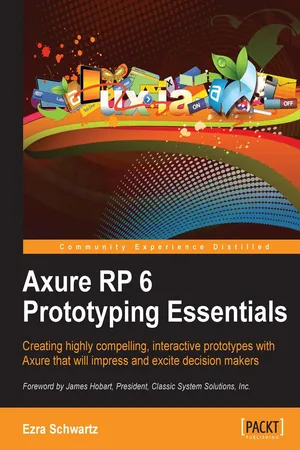![]()
Axure RP 6 Prototyping Essentials
![]()
Table of Contents
Axure RP 6 Prototyping Essentials
Credits
Foreword
About the Author
Acknowledgement
About the Reviewers
www.PacktPub.com
Support files, eBooks, discount offers and more
Why Subscribe?
Free Access for Packt account holders
Instant Updates on New Packt Books
Preface
What this book covers
What you need for this book
Who this book is for
Conventions
Reader feedback
Customer support
Downloading the example code
Errata
Piracy
Questions
1. Prototyping Fundamentals
The art of UX prototyping
Prototyping interaction
The prototyping checklist
The project
Simple websites
Web applications and portals
Mobile apps
Heuristic evaluation
User validation
Deliverables: Prototype and specifications
Balancing act: What stakeholders have to say
Business stakeholders
Management
Business process architects
Project management
Visual design
Development stakeholders
The UX perspective
The UX practitioner
The UX team lead
The challenge
Team structure
Process
Extending the process
Axure: The Good
Axure: The Bad
Tips for using Axure on large design projects
Axure around the world
The Axure perspective
Summary
2. Axure Basics—the User Interface
Getting started
Working with multiple project files
The Axure workspace
Customizing the workspace
The Sitemap pane
Wireframe pages
Flow pages
The Page Properties pane
Page notes
Managing notes
Page interactions
Page formatting
Sketch effects
The Widgets pane
Wireframe Widgets
Flow widgets
Creating your own widget library
Third party widget libraries
The Widget Properties pane
Annotation tab
Annotation fields
Annotation views
Interactions tab
Interactions
Events
Cases
Actions
Formatting tab
Location and size
Font
Alignment + Padding
Style
Ordering
Fills, Lines, + Borders
The Wireframe pane
Grid and Guides
The Masters pane
Master behavior
Normal
Place in Background
Custom Widget
Usage Report
The Dynamic Panel Manager
The toolbar and menu bar
Axure file formats
The .RP file format (stand-alone)
The RPPRJ file format (shared project)
Summary
3. Prototype Construction Basics
Prototyping principles
Alexandria, the Digital Library Project
Getting started—productivity in 30 minutes
Initial requirements and use cases
Use case diagram page
Saving the project file
First wireframe pages
Task flow diagram page
Browse path flow diagram
Search path flow diagram
Link use cases to flow diagrams
Generating the HTML prototype
Getting started with masters and dynamic Panels
The first wireframe
The quick and dirty approach
The quick but structured approach
First masters: navigation systems
Global navigation bar
Secondary navigation system
The first dynamic panel
Adding states to a dynamic panel
Adding visual effects
Adding sketch effects
Updating task flow diagrams
Practitioner's corner—Axure prototyping for mobile devices
Mobile-friendly websites and mobile apps
Different device resolutions and aspect ratios
Using the Viewport Tag
Using a full screen browser
Landscape and portrait page versions
Event and gesture compatibility
Browser limitations
Using widget libraries
Loading prototypes onto the device
Summary
4. Interactivity 101
Interaction design—brief history
The 1950–60s
The 1970–80s
The 1990–2000s
The present, future, and Axure interactions
Axure interactions primer
Guided example
Step 1: Defining the interaction in simple words
Step 2: The Axure interface
Step 3: Translating this requirement into an Axure interaction
Step 4: Annotating the interaction (optional?)
Axure events
Events triggered on OnPageLoad
Guided example: Changing the default landing page
Simulating contextual navigation
OnPageLoad events and dynamic panels
OnPageLoad event in detail
User triggered events
Guided example: Sign-in
Construction strategy
Adding the interaction
Organizing actions
Widget, Events, and Context
Widget Events in detail
Axure cases
Guided example: Construction and interactions
Part 1: Construction tweaks
Part 2: Adding interactions
Axure actions
Links actions
Dynamic panel actions
Widgets and variables actions
Miscellaneous actions
Summary
5. Advanced Interactions
Conditions
If-Then-Else
Guided example—conditions and dynamic panels
Step 1: Defining the interaction
Step 2: Constructing Wireframe
Step 3: Setting the first condition
Step 4: Adding the first interaction
Step 5: Completing the interaction
The Condition Builder
Guided example—multiple conditions
Step 1: Defining the interaction
Step 2: Constructing Wireframe
Step 3: Interaction tweaks
Step 4: Evaluating multiple conditions
Satisfy all or any
Step 5: Final conditional touches
Troubleshooting conditions
Raised events
Guided example
Step 1: Creating a raised event on the master
Step 2: Applying interaction to raised events on a page
Nested masters: Amplifying the raised event
Variables
Guided example—creating context with variables
Step 1: Defining the interaction
Step 2: Construction considerations: Dynamic panel or pages?
Step 3: Adjusting existing conditions
Step 4: Variables and the order of actions
Step 5a: Setting variables (and possible snags)
Step 5b: Setting and initializing variables
Initializing, passing, and resetting variables
Step 6: Using variable values to determine appropriate cases
Variable types
Global variables
Axure's built-in variable
Create your own variables
Special variables
Usage examples
Local variables and functions
Naming variables
How variables can help in usability testing
Guided example—contextual usability testing
Pros and cons of using variables
Tips and techniques from the experts
Hiding and showing list elements, by Jeff Harrison
The approach
Step 1: Creating the row template
Step 2: Moving rows together
Step 3: Repeating as desired
Step 4: Adding controls
Keyboard Shortcuts by Loren Baxter
High-level Interaction
Detailed steps
Notes
Axure tricks by Fred Beecher
Trick 1: Debugging your Logic
Trick 2: Passing variable values between pages
Trick 3: Hidden link to clear variables
Trick 4: Text fields masquerading as text pa...
